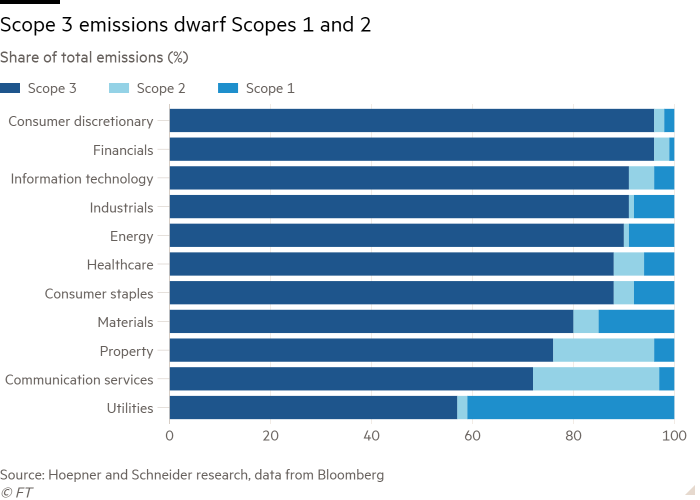Why carbon emissions reports need handling with care. . .

Roula Khalaf, Editor of the FT, selects her favourite stories in this weekly newsletter.
The writer is assistant professor of finance at Dublin City University, and a member of the GreenWatch team that analysed the Europe’s Climate Leaders 2023 list
In financial reporting, rigour is everything: companies whose numbers don’t add up can look forward to a rough ride from regulators and investors. But we are a long way from that rigour when it comes to reporting on greenhouse gas emissions — and the consequences for all of us, in the form of extreme weather due to global warming, are far harsher.
For the biggest institutional investors, this is a manageable problem — as is evident from the €116bn invested in Paris-aligned benchmark (PAB) indices. Introduced by the European Commission in 2019, the PABs’ constituent companies have to be cutting their emissions by enough to reach net zero by 2050: 7 per cent every year.
But smaller investors, and especially civil society, should not assume that this means all is well with GHG reporting. On the contrary, corporate emissions data cannot always be taken at face value. Too often, companies’ reporting gives a misleading sense of how much progress has been made towards a net zero target.
Even data supplied to established sources like CDP — a non-profit that runs a platform for environmental disclosure — does not always add up. Analysis carried out by my colleagues at University College Dublin, plus Imperial College London and the University of Bamberg, found that, for 39 per cent of oil and gas companies, the sum of their emissions broken down by region or business line did not equal their total reported emissions.
And that was for emissions arising directly from the companies’ own operations — so-called Scope 1 emissions — where procedures for gathering and reporting data are most developed.
Greenhouse gas emissions: know your Scopes
Scope 1: Emissions that come directly from company assets, such as facilities or vehicles. These are under the immediate control of the firm, and are what people most commonly associate with emissions — the “dirty” ones that we see issuing from chimneys and exhaust pipes.
Scope 2: Indirect emissions from purchased energy, such as electricity for heating as well as cooling. Though less obvious than Scope 1 emissions, these are still related to energy consumed as part of the company’s own operations.
Scope 3: Emissions that lie outside the company’s own boundaries, elsewhere in its value chain. They include upstream emissions in the supply chain — for example, from goods purchased — as well as downstream emissions, such as those arising from distribution, waste management and from use of the product the company sells. Scope 3 also captures emissions from investments (“balance sheet emissions”), business travel, and leasing.
The situation is far worse with Scope 3 emissions, which come from all parts of the value chain outside the company’s boundaries, while Scope 2 emissions, from purchased energy, lie somewhere in between.
So how might emissions reporting be strengthened? That is the question driving a critical review that I am carrying out with four fellow academics: Matthew Brander at the University of Edinburgh; Andreas Hoepner and Tushar Saini at University College Dublin; and Joeri Rogelj at Imperial. Our initial findings suggest several improvements that could deliver the robust, scalable data that investors and policymakers require.
One area that needs urgent attention relates to electricity usage, as part of Scope 2 emissions. The Greenhouse Gas Protocol — the voluntary framework that sets out the “Scopes” system — allows two ways of reporting this: using a so-called market-based, or a location-based, approach.
With market-based reporting, companies report on the emissions from electricity contracts that they have chosen. In practice, this means buying renewable energy certificates (RECs), which electricity providers can sell whenever they supply 1 MwH, and which companies can set against the energy they actually consume — however dirty it may be.
Though these RECs rarely correspond to the actual physical electricity supplied to the companies purchasing them, the assumption is that, in buying them, companies will incentivise providers to produce more renewable energy. But that assumption is wrong: research indicates that REC purchases are unlikely to lead to additional renewable energy production.
With location-based reporting, on the other hand, regional grid averages are used to calculate emissions, disregarding purchasing decisions. Here, the point to note is that average grid mix is different from residual grid mix — the generation (and emissions) remaining after RECs have been claimed and removed from the calculation. The upshot is that the location-based method includes the same renewable electricity that is sold separately and bought by companies to claim zero emissions under the market-based method.
So the location-based approach can enable “free riders” to pay less than others towards greening the grid.
That, however, is a Scope 2 issue. And where emissions reporting has really stumbled so far is at the level above: Scope 3.
Generally, the higher the scope, the worse the availability and quality of data. For a long time, Scope 3 emissions have been excluded from mandatory disclosure requirements as well as from net zero claims for being “outside the control” of the company — a dubious shifting of blame that smacks of greenwashing.
Yet the magnitude of Scope 3 emissions demonstrates why taking action on them has to be a key component of climate leadership.
In 2021, for example, ExxonMobil’s self-reported emissions from the use of sold products (530 Mt CO₂-equivalent) would place it among the top 20 GHG-emitting countries. And that is just one out of the 15 Scope 3 subcategories that the GHG Protocol lists for companies to report on.

On average, across all 11 sectors in our research, Scope 3 accounts for 86 per cent of total emissions (see chart above). No company can legitimately boast about its green credentials while addressing only about 15 per cent of its total emissions. These emissions may be outside company boundaries, but shifting blame to suppliers and customers is an evasion of responsibility. These are the company’s purchases, the company’s product.
If a business model is based on an emission-intensive product, consumers are eventually likely to switch — due to preference, regulation or innovation — to a more sustainable alternative. So emissions from the use of sold products are a good indicator of transition risk, and investors should take note.
Where data is not qualitatively comparable, or it is necessary to rely on estimates, it is crucial for investors to apply the precautionary principle.
Rather than omitting non-reporting firms or estimating their emissions based on industry averages, a prudent assessor should assume the worst. If it becomes standard practice to estimate a value from the 95th centile upwards, non-disclosers will not get to hide behind an average. After all, it’s unlikely they are not disclosing because their performance is above average.
Such an approach would incentivise self-reporting, instead of giving the benefit of the doubt to “greenhushers”. And it’s certainly technically feasible: methodologies along these lines are already used by some data providers, which offer clients a threshold choice when estimating missing information.
Where data is not as full as they would like, investors should still hold companies to account: the need to curb emissions demands nothing less. And, when they are in doubt, my colleague Andreas has a simple rule of thumb: err on the side of the planet, not on the side of commerce.
Climate Capital

Where climate change meets business, markets and politics. Explore the FT’s coverage here.
Are you curious about the FT’s environmental sustainability commitments? Find out more about our science-based targets here

Comments